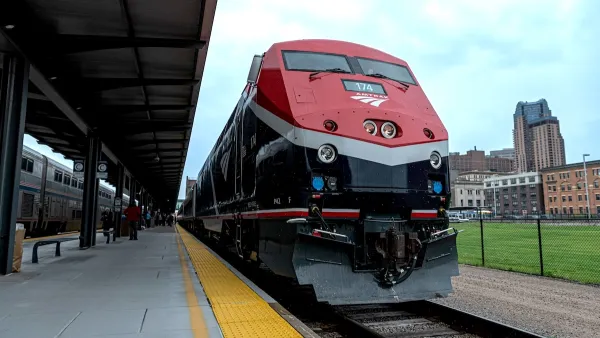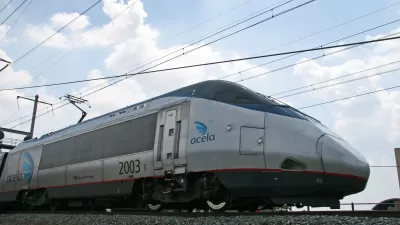The agency’s plan to study potential passenger rail routes is giving hope to transit advocates in the historically car-oriented state.

A $2.5 million grant from the Federal Railroad Administration (FRA) will fund five studies on passenger rail in Texas, raising new hopes for reviving service on the long-dormant Dallas-to-Houston corridor. The Texas Eagle once ran on the rails connecting the two cities, but was discontinued due to low ridership, writes Megan Kimble in Texas Monthly.
As Kimble explains, “TxDOT applied for three passenger rail studies that would connect the so-called Texas Triangle, encompassing Austin, Dallas–Fort Worth, Houston, and San Antonio. Two of the three corridors were funded, one to restore service between Dallas and Houston and another to expand service between Houston and San Antonio along an existing Amtrak line.”
The region accounts for almost 90 percent of Texas’ population growth over the last 10 years, Kimble points out. “In its grant application, the agency acknowledged that Texas highways are among the most congested in the nation and that adding passenger rail would alleviate road congestion, improve safety, and reduce emissions.”
The department’s application is significant in part because it signals a new willingness to consider passenger rail as part of its future strategy. Earlier this year, Amtrak announced it is ‘exploring’ a partnership to revive a Central Texas high-speed rail (HSR) plan. However, Kimble writes that conventional rail could be “more politically palatable in the Texas Legislature,” would cost less than HSR, and could serve more stops.
FULL STORY: New Hopes for a Train From Dallas to Houston

Planetizen Federal Action Tracker
A weekly monitor of how Trump’s orders and actions are impacting planners and planning in America.

San Francisco's School District Spent $105M To Build Affordable Housing for Teachers — And That's Just the Beginning
SFUSD joins a growing list of school districts using their land holdings to address housing affordability challenges faced by their own employees.

The Tiny, Adorable $7,000 Car Turning Japan Onto EVs
The single seat Mibot charges from a regular plug as quickly as an iPad, and is about half the price of an average EV.

Seattle's Plan for Adopting Driverless Cars
Equity, safety, accessibility and affordability are front of mind as the city prepares for robotaxis and other autonomous vehicles.

As Trump Phases Out FEMA, Is It Time to Flee the Floodplains?
With less federal funding available for disaster relief efforts, the need to relocate at-risk communities is more urgent than ever.

With Protected Lanes, 460% More People Commute by Bike
For those needing more ammo, more data proving what we already knew is here.
Urban Design for Planners 1: Software Tools
This six-course series explores essential urban design concepts using open source software and equips planners with the tools they need to participate fully in the urban design process.
Planning for Universal Design
Learn the tools for implementing Universal Design in planning regulations.
Smith Gee Studio
City of Charlotte
City of Camden Redevelopment Agency
City of Astoria
Transportation Research & Education Center (TREC) at Portland State University
US High Speed Rail Association
City of Camden Redevelopment Agency
Municipality of Princeton (NJ)





























